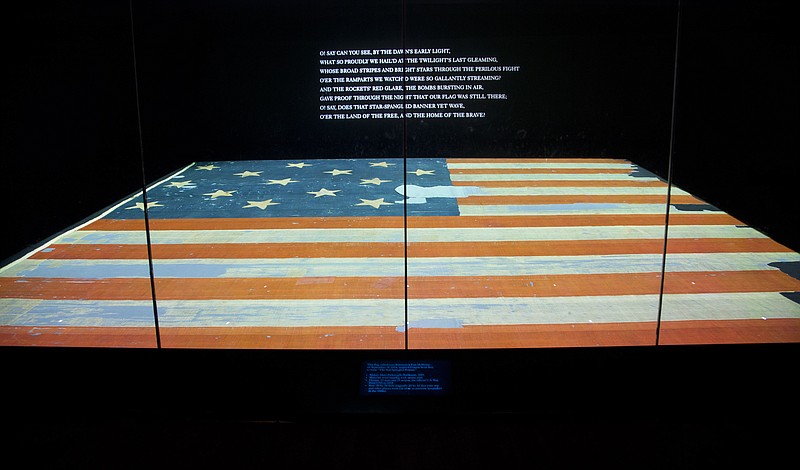Each year, Flag Day takes place on June 14, the day in 1777 when the Continental Congress officially issued the United States flag.
As familiar as the nation's colors are to most of us, five facts about the first Flag Day are quite surprising.
1 The U.S. flag wasn't Congress' top priority on the first Flag Day. Because companies today spend big bucks and countless hours releasing the next must-have iPhone or must-see "Spider-Man" movie, it's hard to imagine a time when no one put much thought into marketing new things. When the Continental Congress met on Saturday, June 14, 1777, topping its agenda was paying bills, followed by worrying about an enemy invasion on the Delaware River. The U.S. flag was the fifth of numerous business items - including sending 2,000 bushels of salt to New York. According to its journal:
"Resolved, that the flag of the 13 United States be 13 stripes, alternate red and white: that the union be 13 stars, white in a blue field, representing a new constellation."
That's it. In just 31 words, Congress officially issued what is now the most recognizable symbol of the USA.
2 Congress didn't mention Betsy Ross or George Washington on the first Flag Day. Why not? Wasn't Betsy Ross the first to sew the flag? The long-held story is that Washington and two other men, including an uncle of Ross' deceased husband, came to her Philadelphia upholstery shop and asked her to create the first U.S. flag. Agreeing to try, she used an efficient technique for cutting five-sided stars.
The problem is a lack of evidence. No letter or drawing from Washington to Ross exists. Congress' journal entry on June 14, 1777, doesn't mention Ross or Washington. In May 1777, Pennsylvania's State Navy Board paid Ross for making flags, which could have included the nation's first. Though the lack of hard evidence makes it impossible to prove for sure that she stitched the first Stars and Stripes, her grandchildren were so confident that they signed sworn affidavits stating that she did. Hence, the legend of Betsy Ross was born as much from swearing as from sewing.
3 Congress unwittingly commissioned the Revolution's most notorious traitor on the first Flag Day. On June 14, 1777, Congress finally gave Gen. Benedict Arnold what he most wanted: a command. They ordered him to take control of all militia from Bristol, Pa., to Philadelphia. They also resolved "that he be authorized to dispose of himself and the troops under his command, in such a manner as he shall deem best adapted to promote the public service."
Three years later, after a court-martial questioned his leadership tactics in Philadelphia, Arnold committed treason. By giving detailed plans about New York's West Point to the British, he became the Revolution's most notorious traitor and broke the trust that Congress gave him that first Flag Day.
4 Congress also commissioned the first U.S. Navy hero on the first Flag Day. After the flag, the next order of business was to suspend a ship captain of questionable character. They replaced him with John Paul Jones.
Little did they know that two years later, the flag would play a role in his most famous words. During a sea battle
with a British ship, the U.S. flag disappeared from Jones' mast, either from cannon fire or from someone deliberately taking it down to signal that the Americans were ready to quit - but Jones wasn't. "Surrender? I have not yet begun to fight!" While his ship sank, Jones captured the British ship, making him the nation's first Navy hero.
5 Congress failed to explain the meaning of "red, white and blue" on the first Flag Day. The first flag's 13 stripes and stars obviously represented the 13 new states. Yet, that's the only symbolism that Congress described that day.
Five years later on June 20, 1782, Congress finally defined the colors when they created the U.S. seal, which features an eagle with a shield. "The colors are those used in the flag of the United States of America. White signifies purity and innocence. Red, hardiness and valor; and blue signifies vigilance, perseverance and justice."
Why didn't they explain the colors earlier? Perhaps Congress couldn't define the colors on the first Flag Day because they didn't know what the colors truly meant.
In 1777, they were stitching a revolution out of a civil war fabric, but by 1782, with the war ending and people united, they understood Jones' red stripe of valor. They knew Washington had told his army that they weren't fighting for themselves, but for the pure motive of the "unborn millions" to come. They understood the need for true-blue justice after Arnold's treason.
Thanks to the first Flag Day and Congress' definitions, we know what our flag means. We also hoist flags today because we know and have heard "the broad stripes and bright stars." Seeing Fort McHenry's giant flag on the morning of Sept. 14, 1814, proved to Francis Scott Key, a Maryland lawyer, that the Americans in Baltimore had defied the British Navy. Forever inspired by the Stars and Stripes, Key wrote an anthem for the ages. His song became America's "Star-Spangled Banner."
We also know what the colors mean because we have heard the stories of grandfathers who stormed Normandy's beaches and raised the flag at Iwo Jima during World War II. We know of those who placed a flag on the moon and those who fought in Vietnam. We know sons and daughters who made sacrifices in Afghanistan and Iraq.
While several facts about the first Flag Day may surprise us today, we hoist our flags on Flag Day for one simple reason. We know our colors.
Jane Hampton Cook is a national media commentator and the author of eight books, including "America's Star-Spangled Story: Celebrating 200 Years of the National Anthem."
